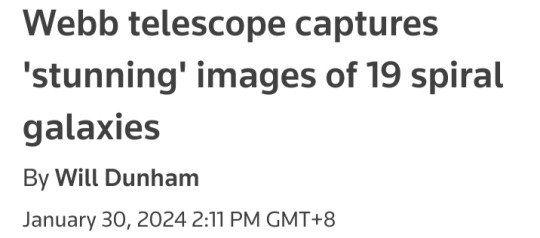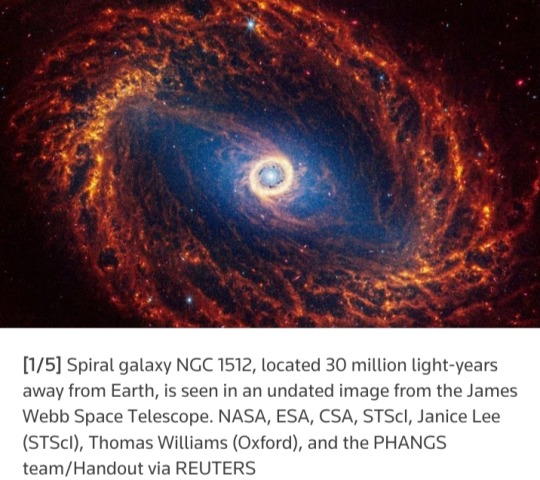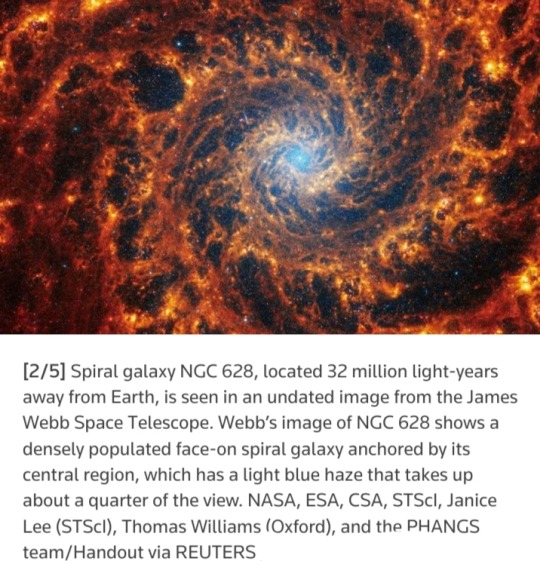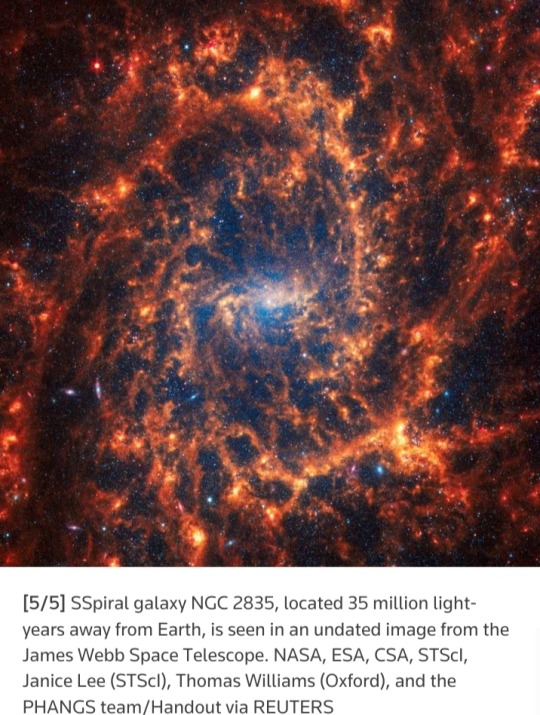#High-Resolution Cameras
Text
Security Features Every Car Storage Facility Must Have

Owning a valuable car can be both a luxury and a responsibility, as ensuring its safety when not in use becomes crucial. As a result, a growing number of vehicle owners are opting for a car club in Fairfield, New Jersey, that provides top-notch security features for their prized possessions.
Read More: https://www.thecarlofts.com/security-features-every-car-storage-facility-must-have
0 notes
Text


WASHINGTON, Jan 29 (Reuters) — A batch of newly released images captured by the James Webb Space Telescope show in remarkable detail 19 spiral galaxies residing relatively near our Milky Way, offering new clues on star formation as well as galactic structure and evolution.
The images were made public on Monday by a team of scientists involved in a project called Physics at High Angular resolution in Nearby GalaxieS (PHANGS) that operates across several major astronomical observatories.
The closest of the 19 galaxies is called NGC5068, about 15 million light years from Earth, and the most distant of them is NGC1365, about 60 million light years from Earth.
A light year is the distance light travels in a year, 5.9 trillion miles (9.5 trillion km).
The James Webb Space Telescope (JWST) was launched in 2021 and began collecting data in 2022, reshaping the understanding of the early universe while taking wondrous pictures of the cosmos.
The orbiting observatory looks at the universe mainly in the infrared.
The Hubble Space Telescope, launched in 1990 and still operational, has examined it primarily at optical and ultraviolet wavelengths.
Spiral galaxies, resembling enormous pinwheels, are a common galaxy type. Our Milky Way is one.
The new observations came from Webb's Near-Infrared Camera (NIRCam) and Mid-Infrared Instrument (MIRI).
They show roughly 100,000 star clusters and millions or perhaps billions of individual stars.
"These data are important as they give us a new view on the earliest phase of star formation," said University of Oxford astronomer Thomas Williams, who led the team's data processing on the images.

"Stars are born deep within dusty clouds that completely block out the light at visible wavelengths - what the Hubble Space Telescope is sensitive to - but these clouds light up at the JWST wavelengths.
We don't know a lot about this phase, not even really how long it lasts, and so these data will be vital for understanding how stars in galaxies start their lives," Williams added.
About half of spiral galaxies have a straight structure, called a bar, coming out from the galactic center to which the spiral arms are attached.
"The commonly held thought is that galaxies form from the inside-out, and so get bigger and bigger over their lifetimes.
The spiral arms act to sweep up the gas that will form into stars, and the bars act to funnel that same gas in towards the central black hole of the galaxy," Williams said.

The images let scientists for the first time resolve the structure of the clouds of dust and gas from which stars and planets form at a high level of detail in galaxies beyond the Large Magellanic Cloud and Small Magellanic Cloud, two galaxies considered galactic satellites of the sprawling Milky Way.
"The images are not only aesthetically stunning, they also tell a story about the cycle of star formation and feedback, which is the energy and momentum released by young stars into the space between stars," said astronomer Janice Lee of the Space Telescope Science Institute in Baltimore, principal investigator for the new data.
"It actually looks like there was explosive activity and clearing of the dust and gas on both cluster and kiloparsec (roughly 3,000 light years) scales.
The dynamic process of the overall star formation cycle becomes obvious and qualitatively accessible, even for the public, which makes the images compelling on many different levels," Lee added.
Webb's observations build on Hubble's.

"Using Hubble, we would see the starlight from galaxies, but some of the light was blocked by the dust of galaxies," University of Alberta astronomer Erik Rosolowsky said.
"This limitation made it hard to understand parts of how a galaxy operates as a system. With Webb's view in the infrared, we can see through this dust to see stars behind and within the enshrouding dust."

#James Webb Space Telescope#spiral galaxies#Milky Way#Physics at High Angular resolution in Nearby GalaxieS (PHANGS)#NGC5068#NGC1365#light year#Hubble Space Telescope#Near-Infrared Camera (NIRCam)#Mid-Infrared Instrument (MIRI)#astronomy#space#universe#cosmos#Large Magellanic Cloud#Small Magellanic Cloud#Space Telescope Science Institute
37 notes
·
View notes
Photo




#Indie Sleaze#hipster#fringe#digital camera#american apperal#tumblr girl#it girl#heroine chic#Flickr#weird#random#odd#strange#dance party#leggings#high exposure#nyc#low resolution#blogger
31 notes
·
View notes
Text
What sucks about being into modern art (I mean like, present-day art, not the movement) is that sometimes you see things in galleries or private viewings that do not end up online in any form so the cherished memory of it taunts you in your head indefinitely.
#catch me emailing an associate professor at Parsons to find out if her video art will ever be given an installation somewhere#please let me see Gahp Song again please please please#this was me with Details by Lorna Simpson for the longest time#they're mostly online now but not in any sort of high resolution#and the prints are very small#camera ephemera
6 notes
·
View notes
Video
youtube
SincereFirst 8MP IMX179 USB3.0 Separate Camera Module
This camera module is a detached high-resolution USB camera module. The camera module has a resolution of 8 million pixels and uses the Sony IMX179 CMOS image sensor. The interface type is USB3.0 and the resolution is 3264×2488. It is widely used. Used in home monitoring, office security, scanning equipment, etc.
#youtube#This camera module is a detached high-resolution USB camera module. The camera module has a resolution of 8 million pixels and uses the Sony#SincereFirst#camera module#Sony IMX179 CMOS image sensor#Sony IMX179#CMOS image sensor#USB camera module#sincerefirst USB camera module#sincerefirst camera module
2 notes
·
View notes
Video
Perspective view of Mars’s Tharsis volcanoes by European Space Agency
Via Flickr:
This oblique perspective view shows a slice of Mars imaged to mark a milestone for ESA’s Mars Express: its 25 000th orbit around the Red Planet. It was generated from a digital terrain model and the nadir (downward-pointing) and colour channels of Mars Express’s High Resolution Stereo Camera. The vertical scale is exaggerated by a factor of approximately three, making the volcanoes look three times higher than they are in real life. Three of Mars’s famously colossal volcanoes are shown here: from left to right, Arsia, Pavonis and Ascraeus Mons. The mound of Mars’s largest volcano, Olympus Mons, can be spied further away at the top of the frame, while the fractured terrain of Noctis Labyrinthus, Mars’s ‘labyrinth of night’, can be seen in the foreground. Read more [Image description: This image shows a tan-coloured portion of Mars, with the curvature of the planet visible to the top left the frame. Four of Mars’s volcanoes can be seen in relief against the dark background, shown as darker mounds stretching away from the viewer.] Credits: ESA/DLR/FU Berlin, CC BY-SA 3.0 IGO
#ESA#European Space Agency#Space#Universe#Cosmos#Space Science#Science#Space Technology#Tech#Technology#Mars#Dunes#Panorama#Marte#Solar System#Sol#Mars Express#HRSC#High Resolution Stereo Camera#DLR#Red Planet#Exploration#Phobos#Volcano#Arsia Mons#Pavonis Mons#Ascraeus Mons#Olympus Mons#Noctis Labyrinthus#flickr
3 notes
·
View notes
Text
found some super old kgpr fanart i drew back in like high school or smth HURHURHUR



2 notes
·
View notes
Text
wishing photo services had a FOR IDIOTS price list, or like used a system that lets you input what you want and then gives you a price for that
#like im paying ~60pln for physical photos + a cd with scanned photos + an index#BUT the photos are 1536x1024 which is not particularly high? or at least doesnt seem so with my p&s camera#maybe the zenit will surprise me#and a bunch of lomoraphy people have their stuff more in the 2000x3000 area which seems lovely! i want in!#but they dont really give you a set price for a physical+cd(2000x3000)+index order! i guess I'd have to ask#OR wait for the zenit pics. maybe they're sharper and look better even in this Moderately Good resolution#shrimp thoughts
3 notes
·
View notes
Text

Got to play with a demo unit of the new Sony Alpha 7R V today and this thing is NICE.
Love the flexibility of the new screen.
2 notes
·
View notes
Text
Enhance Your Security with Pyrotech Electronics Pvt Ltd CCTV Cameras
When it comes to safeguarding your home or business, Pyrotech Electronics Pvt Ltd is your go-to source for top-tier CCTV solutions. Our range of CCTV cameras combines cutting-edge technology with unmatched reliability to offer you the best in security surveillance.
Why Choose Pyrotech Electronics Pvt Ltd for CCTV Cameras?
Superior Image Quality
Our CCTV cameras are engineered to deliver high-resolution video, ensuring every detail is captured with clarity. Whether you need sharp images for identification or broad coverage for general monitoring, our cameras provide excellent visual performance.
State-of-the-Art Technology
At Pyrotech Electronics Pvt Ltd, we use the latest advancements in CCTV technology. Our offerings include HD, IP, and PTZ cameras, each designed to provide exceptional performance and adaptability for various security needs.
Robust and Reliable
Built to last, our CCTV cameras are constructed with durability in mind. They are designed to operate effectively in diverse environmental conditions, ensuring consistent performance and reliability.
Advanced Features
Our cameras come equipped with a range of advanced features to enhance your surveillance system. From night vision capabilities and motion detection to remote monitoring and control, Pyrotech Electronics Pvt Ltd cameras offer sophisticated solutions to keep your property secure.
Versatile Solutions
We offer a wide range of CCTV cameras suitable for residential, commercial, and industrial applications. Whether you need comprehensive coverage for a large facility or focused monitoring for a smaller space, Pyrotech Electronics Pvt Ltd has the right solution for you.
Explore Our CCTV Camera Range:
HD CCTV Cameras: Capture every detail with high-definition clarity, perfect for precise monitoring and security.
IP Cameras: Utilize network-based surveillance for flexible installation and remote access, allowing you to monitor your premises from anywhere.
PTZ Cameras: Gain comprehensive coverage with pan, tilt, and zoom capabilities, ideal for large areas and detailed observation.
Day/Night Cameras: Ensure clear video footage even in low-light or nighttime conditions with advanced low-light technology.
Secure Your Property with Confidence
Choose Pyrotech Electronics Pvt Ltd for your CCTV camera needs and experience the difference that high-quality, reliable surveillance technology can make. Our dedication to innovation and customer satisfaction ensures you receive the best security solutions available.
For more details about our CCTV cameras or to discuss how we can meet your specific security requirements, please get in touch with us. Pyrotech Electronics Pvt Ltd is committed to providing superior CCTV solutions to keep your environment safe and secure.
#CCTV Cameras#Security Solutions#Pyrotech Electronics Pvt Ltd#High-Resolution Surveillance#HD CCTV Cameras#IP Cameras#PTZ Cameras#Night Vision Cameras#Security Technology#Reliable Surveillance#Advanced CCTV Features#Home Security#Commercial Security#Industrial Surveillance#Surveillance Solutions
0 notes
Text
Orbbec Femto Bolt ToF Camera
Techie Tech Tech!
The Orbbec Femto Bolt stands strong as a compact and high-performance device, aimed at meeting the demanding needs of AI developers and those engaged in 3D vision applications. This multi-mode Depth and RGB camera, is equipped with a USB-C connection for power and data, presenting itself as a versatile and cost-effective solution. Its capabilities make it an attractive option for developers…
#3D camera for smart retail#3D sensing technology#best AI development camera#compact 3D vision device#crazydiscostu#depth measurement camera#depth-sensing camera for medical use#dev#development#Femto Bolt ToF technology#Femto Bolt vs Azure Kinect#gaming#geek#high resolution depth camera#high-performance depth camera#Nerd#Orbbec 3D vision camera#Orbbec AI camera SDK#Orbbec depth-sensing camera setup#Orbbec Femto Bolt accuracy#Orbbec Femto Bolt applications#Orbbec Femto Bolt for rehabilitation#Orbbec Femto Bolt imaging capabilities#Orbbec Femto Bolt indoor use#Orbbec Femto Bolt integration#Orbbec Femto Bolt performance#Orbbec Femto Bolt review#Orbbec Femto Bolt specifications#Orbbec multi-mode camera#programmable 3D vision camera
0 notes
Photo



#Troll face#hipster#Indie Sleaze#tattoo#weird#odd#random#strange#sticker#digital camera#meme#old meme#nerdy#geek#low resolution#high exposure#blogger
14 notes
·
View notes
Text
DJI Mini Drone (4K)
🚁✨ New blog post alert! Discover the amazing DJI Mini Drone (4K) – perfect for capturing stunning aerial shots! 📸🌍
#DJIMiniDrone #4KDrone #AerialPhotography #TechReview #DroneLovers #FlyHigh
Visit the DJI Store
Style: Mini 4K (31-min)Brand: DJIModel Name: MT2SDSpecial Feature: For Beginners, Long Distance Control, under 249 g, Regulation Friendly, 38kph (Level 5) Wind Resistant, 3-Axis Gimbal and EIS, 10km HD Video Transmission, 4K Ultra HD, Auto-Landing, Boost Your Inspiration with Quick Shots, Auto Return to Home, Various Beginner Tutorials, One Button ReturnAge Range:…

View On WordPress
#4K Camera Drone#4K Drone#Aerial Photography#Beginner Drones#Best Drones 2024#Compact Drone#DJI Mini Drone#Drone Accessories#Drone Features#Drone Flying Tips#Drone Reviews#Drone Technology#High-Resolution Drone#Mini Drone#Portable Drone
0 notes
Text
Microscope system sharpens scientists’ view of neural circuit connections
New Post has been published on https://thedigitalinsider.com/microscope-system-sharpens-scientists-view-of-neural-circuit-connections/
Microscope system sharpens scientists’ view of neural circuit connections


The brain’s ability to learn comes from “plasticity,” in which neurons constantly edit and remodel the tiny connections called synapses that they make with other neurons to form circuits. To study plasticity, neuroscientists seek to track it at high resolution across whole cells, but plasticity doesn’t wait for slow microscopes to keep pace, and brain tissue is notorious for scattering light and making images fuzzy. In an open access paper in Scientific Reports, a collaboration of MIT engineers and neuroscientists describes a new microscopy system designed for fast, clear, and frequent imaging of the living brain.
The system, called “multiline orthogonal scanning temporal focusing” (mosTF), works by scanning brain tissue with lines of light in perpendicular directions. As with other live brain imaging systems that rely on “two-photon microscopy,” this scanning light “excites” photon emission from brain cells that have been engineered to fluoresce when stimulated. The new system proved in the team’s tests to be eight times faster than a two-photon scope that goes point by point, and proved to have a four-fold better signal-to-background ratio (a measure of the resulting image clarity) than a two-photon system that just scans in one direction.
“Tracking rapid changes in circuit structure in the context of the living brain remains a challenge,” says co-author Elly Nedivi, the William R. (1964) and Linda R. Young Professor of Neuroscience in The Picower Institute for Learning and Memory and MIT’s departments of Biology and Brain and Cognitive Sciences. “While two-photon microscopy is the only method that allows high-resolution visualization of synapses deep in scattering tissue, such as the brain, the required point-by-point scanning is mechanically slow. The mosTF system significantly reduces scan time without sacrificing resolution.”
Scanning a whole line of a sample is inherently faster than just scanning one point at a time, but it kicks up a lot of scattering. To manage that scattering, some scope systems just discard scattered photons as noise, but then they are lost, says lead author Yi Xue SM ’15, PhD ’19, an assistant professor at the University of California at Davis and a former graduate student in the lab of corresponding author Peter T.C. So, professor of mechanical engineering and biological engineering at MIT. Newer single-line and the mosTF systems produce a stronger signal (thereby resolving smaller and fainter features of stimulated neurons) by algorithmically reassigning scattered photons back to their origin. In a two-dimensional image, that process is better accomplished by using the information produced by a two-dimensional, perpendicular-direction system such as mosTF, than by a one-dimensional, single-direction system, Xue says.
“Our excitation light is a line, rather than a point — more like a light tube than a light bulb — but the reconstruction process can only reassign photons to the excitation line and cannot handle scattering within the line,” Xue explains. “Therefore, scattering correction is only performed along one dimension for a 2D image. To correct scattering in both dimensions, we need to scan the sample and correct scattering along the other dimension as well, resulting in an orthogonal scanning strategy.”
In the study the team tested their system head-to-head against a point-by-point scope (a two-photon laser scanning microscope — TPLSM) and a line-scanning temporal focusing microscope (lineTF). They imaged fluorescent beads through water and through a lipid-infused solution that better simulates the kind of scattering that arises in biological tissue. In the lipid solution, mosTF produced images with a 36-times better signal-to-background ratio than lineTF.
For a more definitive proof, Xue worked with Josiah Boivin in the Nedivi lab to image neurons in the brain of a live, anesthetized mouse, using mosTF. Even in this much more complex environment, where the pulsations of blood vessels and the movement of breathing provide additional confounds, the mosTF scope still achieved a four-fold better signal-to-background ratio. Importantly, it was able to reveal the features where many synapses dwell: the spines that protrude along the vine-like processes, or dendrites, that grow out of the neuron cell body. Monitoring plasticity requires being able to watch those spines grow, shrink, come, and go across the entire cell, Nedivi says.
“Our continued collaboration with the So lab and their expertise with microscope development has enabled in vivo studies that are unapproachable using conventional, out-of-the-box two-photon microscopes,” she adds.
So says he is already planning further improvements to the technology.
“We’re continuing to work toward the goal of developing even more efficient microscopes to look at plasticity even more efficiently,” he says. “The speed of mosTF is still limited by needing to use high-sensitivity, low-noise cameras that are often slow. We are now working on a next-generation system with new type of detectors such as hybrid photomultiplier or avalanche photodiode arrays that are both sensitive and fast.”
In addition to Xue, So, Boivin, and Nedivi, the paper’s other authors are Dushan Wadduwage and Jong Kang Park.
The National Institutes of Health, Hamamatsu Corp., Samsung Advanced Institute of Technology, Singapore-MIT Alliance for Research and Technology Center, Biosystems and Micromechanics, The Picower Institute for Learning and Memory, The JPB Foundation, and The Center for Advanced Imaging at Harvard University provided support for the research.
#Arrays#author#background#Biological engineering#Biology#blood#blood vessels#box#Brain#Brain and cognitive sciences#brain cells#brain imaging#Cameras#cell#Cells#challenge#Collaboration#development#dimensions#direction#engineering#engineers#Environment#Features#form#Foundation#harvard#Health#High-Resolution#hybrid
0 notes
Text
#Aerial Photography#BIONZ XR Image Processing Engine#Drone Photography#High-Resolution Sensor#Interchangeable E-Mount Lens System#Lightweight Design#Mountain Photography#Nature Photography#Remote Operation#Sony Camera Remote SDK#Sony ILX-LR1
0 notes
Text
youtube
#Sonos#Tivoli audio#DAC#Hidizs#USB DAC#roon#line-in#aux in#dab radio#FM#FM radio#FM radio station#Apple Airport Express#Apple TV#HDMI audio extractor#MacBook#Mac studio#Sonos Port#Sonos Five#HDMI#sampling rate#lossless#lossless audio#high resolution lossless#hi-res lossless#Razer#microphone#web camera#Apple Music#Tidal
1 note
·
View note